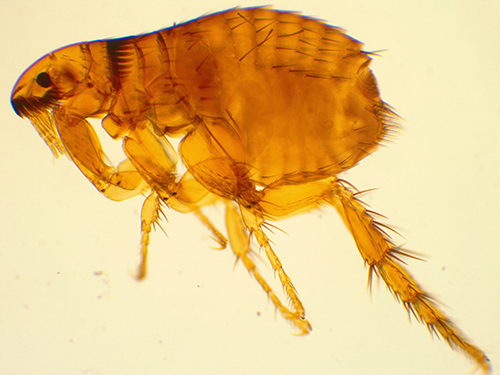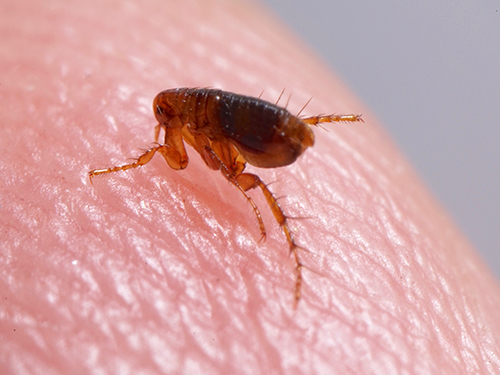Communicable Diseases
Typhus
Dallas County Health and Human Services - 2377 N. Stemmons Freeway, Dallas, TX 75207
Telephone: 214-819-2000
Flea-borne typhus is a disease caused by a bacteria (germs) that is spread by infected fleas. Fleas can become infected when they bite infected animals, such as cats, squirrels, rats, mice, or opossums.
Transmission
When an infected flea bites a person, the bite breaks the skin creating a small wound. Fleas also poop when they feed. The poop (sometimes called flea dirt) may then be rubbed into the bite wound or other wounds leading to a typhus infection. People can also breathe in flea dirt or rub it into their eyes.
Typhus is not transmitted from person-to-person.
Symptoms
Symptoms of typhus can begin within two weeks after contact with infected fleas or flea dirt. However, people may not always be sure or remember if they were bitten by a flea so be sure to tell your healthcare provider about any outdoor activities or contact with animals. Symptoms may include:
- Fever
- Chills
- Body aches and muscle pain
- Loss of appetite
- Nausea
- Vomiting
- Stomach pain
- Cough
- Rash (would typically occur around the 5th day of illness)
Treatment
Flea-borne typhus is treated with antibiotics, usually doxycycline. Antibiotics are most-effective when given soon after symptoms begin. People given doxycycline usually recover quickly, and there is no evidence that persistent or chronic infections occur.
Frequently Asked Questions
What do fleas look like?
Fleas are very small, dark, oval-shaped, wingless bugs that may look like specks of dust. They may not be visible to the naked eye, as they’re about 0.1 inches long.

Close-up of a flea.

A flea on a finger-tip.
How do fleas move around?
Fleas can jump about 1 foot, making it easy for them to move from one host to the next. Also, flea eggs laid on an animal can fall and lodge in the crevices of carpets and furniture and can start an infestation if not treated properly. Fleas can be brought into a home by pets that go outside or stay outside. Fleas can also be found on stray animals, such as stray cats, rats, opossums that might hang around neighborhoods or your home.
How do I protect myself from fleas?
- Treat pets with flea/tick prevention medication regularly.
- Wear EPA registered insect repellant containing DEET when hiking, camping, gardening, hunting, or any other outdoor activities
- Wear long sleeves and pants and socks tucked over your pants to protect from bites. Permethrin or DEET can be applied on clothes.
- Machine wash and dry all of your clothing in a hot cycle when you return home to ensure there are no eggs on them.
- Keep rodents and wild animals away from your home.
How do you treat your home if fleas get inside?
Remember fleas will only persist if you have animals or rodents on which they can live. If you believe you have a flea problem in your home, you can:
- Vacuum all furnishings, upholstery, crevices of carpets, and floors to suck up the fleas or flea eggs and empty the vacuum bag afterwards in the outside garbage. Keep vacuuming everyday consistently.
- Hot soapy water kills fleas.
- Steam clean carpets: the hot steam and soap can kill fleas in all stages of the life cycle, especially areas where pets sleep.
- Wash all pet bedding and family bedding on which pets lie in hot, soapy water every two to three weeks. If an infestation is severe, discard old pet bedding and replace it with fresh, clean material.
- If you have pets, use a flea comb to remove adult fleas, especially the neck and tail areas, which is where the most fleas congregate. Hair can pass through the comb's teeth, but not the fleas.
- Use flea control products on your pets.
- Be sure to read and follow all label directions on any flea pesticide product you may use.
More Information
QUICK LINKS
LOCATIONS
EMPLOYEES
-
You must be on the network to see these links.





